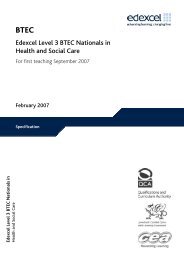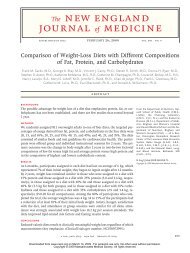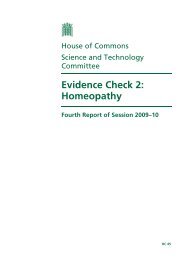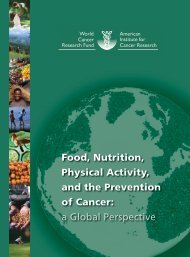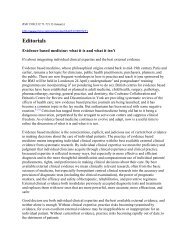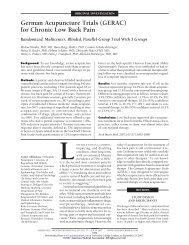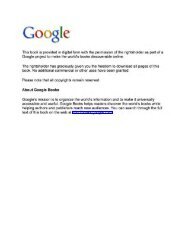A systematic review of randomised clinical trials - Postgraduate ...
A systematic review of randomised clinical trials - Postgraduate ...
A systematic review of randomised clinical trials - Postgraduate ...
Create successful ePaper yourself
Turn your PDF publications into a flip-book with our unique Google optimized e-Paper software.
633<br />
REVIEW<br />
A <strong>systematic</strong> <strong>review</strong> <strong>of</strong> <strong>randomised</strong> <strong>clinical</strong> <strong>trials</strong> <strong>of</strong><br />
individualised herbal medicine in any indication<br />
R Guo, P H Canter, E Ernst<br />
...................................................................................................................................<br />
Postgrad Med J 2007;83:633–637. doi: 10.1136/pgmj.2007.060202<br />
See end <strong>of</strong> article for<br />
authors’ affiliations<br />
........................<br />
Correspondence to:<br />
Peter H Canter, Peninsula<br />
Medical School, Universities<br />
<strong>of</strong> Exeter & Plymouth, 25<br />
Victoria Park Road, Exeter,<br />
EX2 4NT, UK; peter.canter@<br />
pms.ac.uk<br />
Received 27 March 2007<br />
Accepted 21 May 2007<br />
........................<br />
Aim: To summarise and critically evaluate the evidence from <strong>randomised</strong> <strong>clinical</strong> <strong>trials</strong> for the effectiveness <strong>of</strong><br />
individualised herbal medicine in any indication.<br />
Methods: Search <strong>of</strong> electronic databases and approaches to experts in the field to identify <strong>randomised</strong>,<br />
controlled <strong>clinical</strong> <strong>trials</strong> <strong>of</strong> individualised herbal medicine in any indication. Independent data extraction and<br />
assessment <strong>of</strong> methodological quality by two authors and best evidence synthesis.<br />
Results: Three <strong>randomised</strong> <strong>clinical</strong> <strong>trials</strong> <strong>of</strong> individualised herbal medicine were identified. Statistically nonsignificant<br />
trends favouring active over placebo treatment in osteoarthritis <strong>of</strong> the knee probably result from<br />
large baseline differences and regression to the mean. Individualised treatment was superior to placebo in<br />
four <strong>of</strong> five outcome measures in the treatment <strong>of</strong> irritable bowel syndrome, but was inferior to standardised<br />
herbal treatment in all outcomes. Individualised herbal treatment was no better than placebo in the prevention<br />
<strong>of</strong> chemotherapy-induced toxicity.<br />
Conclusions: There is a sparsity <strong>of</strong> evidence regarding the effectiveness <strong>of</strong> individualised herbal medicine and<br />
no convincing evidence to support the use <strong>of</strong> individualised herbal medicine in any indication.<br />
Evidence <strong>of</strong> efficacy for some herbal medicines, but by no<br />
means for all those in common use, has increased<br />
substantially in the past 20 years. 1 However, most <strong>clinical</strong><br />
<strong>trials</strong> <strong>of</strong> herbal medicine have focused on either standardised<br />
extracts <strong>of</strong> single herbs or standardised formulae reflecting<br />
increased sponsorship <strong>of</strong> such studies by manufacturers in the<br />
increasingly important over-the-counter market. The individualised<br />
approach, in which patients receive tailored prescriptions<br />
comprising a mixture <strong>of</strong> herbs, is emphasised in most<br />
forms <strong>of</strong> practitioner based herbalism, including European<br />
medical herbalism, Chinese herbal medicine and Ayurvedic<br />
herbal medicine. The World Health Organization has estimated<br />
that 80% <strong>of</strong> the population in developing countries depends<br />
primarily upon herbal medicine for basic health care. 2 Evidence<br />
from <strong>clinical</strong> studies <strong>of</strong> single herb extracts or standardised<br />
formulae cannot be generalised to individualised herbal<br />
medicine, and claims by practitioners that the latter has an<br />
evidence base requires confirmation. The non-standardised<br />
nature <strong>of</strong> individually prepared herbal prescriptions and the<br />
consequent increased potential for adverse events and negative<br />
interactions 1 means that safety and effectiveness need to be<br />
firmly established before such practices can be endorsed. This<br />
<strong>systematic</strong> <strong>review</strong> aims to summarise and critically evaluate the<br />
evidence from <strong>randomised</strong> <strong>clinical</strong> <strong>trials</strong> for the effectiveness <strong>of</strong><br />
individualised herbal medicine in any indication. The findings<br />
<strong>of</strong> this <strong>review</strong> are particularly pertinent because section 12(1) <strong>of</strong><br />
the UK’s Medicines Act relating to regulation <strong>of</strong> unlicensed<br />
herbal remedies made up to meet the needs <strong>of</strong> individual<br />
patients is presently under <strong>review</strong>.<br />
METHODS<br />
Searching<br />
We searched for <strong>randomised</strong> <strong>clinical</strong> <strong>trials</strong> (RCTs) <strong>of</strong> any form<br />
<strong>of</strong> individualised herbal medicine in any indication in electronic<br />
databases (Medline, Embase, Cochrane Library, CINAHL,<br />
AMED) from the inception <strong>of</strong> the respective database to<br />
February 2007 using the search algorithm: [Individual$ OR<br />
tailored OR personal$ OR standard$ OR herbal$] AND [Kampo<br />
OR herb$ OR plant$ OR Phyto$ OR botanic$ OR extract$ OR<br />
(traditional OR Chinese OR herbal OR oriental ADJ medicine)].<br />
No language restrictions were imposed. Additional studies were<br />
sought by searching the reference lists <strong>of</strong> identified <strong>trials</strong> and<br />
<strong>review</strong>s, contacting experts in the field who have published<br />
similar studies <strong>of</strong> herbal medicine (n = 5), contacting pr<strong>of</strong>essional<br />
bodies <strong>of</strong> herbal medicine practitioners, and by hand<br />
searching all back issues <strong>of</strong> the <strong>review</strong> journal FACT. The<br />
following 15 pr<strong>of</strong>essional bodies were contacted: European<br />
Herbal Practitioners Association; The Herb Society; The Register<br />
<strong>of</strong> Chinese Herbal Medicine; The College <strong>of</strong> Practitioners <strong>of</strong><br />
Phytomedicine; The Herb Society <strong>of</strong> America; Ayurvedic<br />
Practitioners Association; National Institute <strong>of</strong> Medical<br />
Herbalists; The National Herbalists Association <strong>of</strong> Australia;<br />
American Herbalists Guild; American Ayurvedic Association;<br />
National Ayurvedic Medical Association; Ontario Herbalists<br />
Association; New Zealand Association <strong>of</strong> Medical Herbalists;<br />
Society for Phytotherapy; British Herbal Medicine Association.<br />
Selection <strong>of</strong> studies<br />
To be included, studies had to be <strong>randomised</strong>, and controlled.<br />
The intervention had to be individualised herbal medicine in<br />
which prescriptions were individually tailored for each patient.<br />
Studies in any indication were included. Studies combining<br />
individualised herbal medicine with other treatments were<br />
excluded unless the design allowed the separate evaluation <strong>of</strong><br />
the effectiveness <strong>of</strong> the herbal medicine component. The study<br />
had to report data on any outcomes for both active and control<br />
treatments to be included. An initial assessment against<br />
inclusion criteria was made by scanning all titles and abstracts<br />
identified by the literature searches (RG). Full text articles <strong>of</strong><br />
potentially relevant references were retrieved and assessed<br />
independently for inclusion by two <strong>review</strong>ers (RG, PC).<br />
Discrepancies were resolved by discussion between the first<br />
two authors (RG, PC) and, if needed, by consulting the third<br />
<strong>review</strong>er (EE).<br />
Abbreviations: BSS, Bowel Symptom Score; IBS, irritable bowel<br />
syndrome; MYMOP, Measure Yourself Outcome Pr<strong>of</strong>ile; RCT, <strong>randomised</strong><br />
<strong>clinical</strong> trial; WOMAC, Western Ontario and McMaster Universities<br />
Osteoarthritis Index<br />
www.postgradmedj.com
634 Guo, Canter, Ernst<br />
Quality assessment <strong>of</strong> studies<br />
Methodological quality <strong>of</strong> the included <strong>trials</strong> was assessed<br />
using the five point Jadad 3 scale. This is a validated measure <strong>of</strong><br />
quality <strong>of</strong> reporting in which points are awarded if the study is<br />
described as <strong>randomised</strong> (+1); the means <strong>of</strong> carrying out<br />
randomisation is described and appropriate (+1); the study is<br />
described as double-blind (+1); the means <strong>of</strong> double-blinding is<br />
described and appropriate (+1); and there is a description <strong>of</strong><br />
withdrawals giving number and reason in both groups (+1).<br />
Points are deducted if the method to generate the sequence <strong>of</strong><br />
randomisation is described and is inappropriate (21); or if the<br />
method <strong>of</strong> double-blinding is described and is inappropriate<br />
(21).<br />
Data extraction<br />
Data concerning the details <strong>of</strong> study design, quality <strong>of</strong> the<br />
study, participants, intervention, outcomes and adverse events<br />
were extracted independently by two authors (RG, PC) using a<br />
pro forma data extraction sheet.<br />
Data analysis<br />
A best evidence synthesis was conducted giving due regard to<br />
the quality <strong>of</strong> studies included. It was anticipated that the data<br />
would be <strong>clinical</strong>ly heterogenous and unsuitable for metaanalysis<br />
and therefore none was planned.<br />
RESULTS<br />
The literature search identified 1345 references. This includes<br />
one completed but unpublished trial and two ongoing <strong>trials</strong><br />
identified through contacts with pr<strong>of</strong>essional bodies and<br />
experts in the field. The initial screening <strong>of</strong> the titles and<br />
abstracts identified 15 potentially relevant references, for which<br />
full text articles were obtained for further evaluation. Only<br />
three <strong>trials</strong> were finally included in our <strong>review</strong>. 4–6 Figure 1<br />
describes the results <strong>of</strong> the search and inclusion/exclusion<br />
process. Agreement between <strong>review</strong>ers about study inclusion<br />
was 100%.<br />
All three included studies are <strong>randomised</strong>, double-blind,<br />
placebo-controlled RCTs <strong>of</strong> moderate to good methodological<br />
quality. Jadad scores for the three studies were 5, 4 3 5 and 5. 6<br />
Studies compared: individualised Chinese herbal medicine,<br />
standardised Chinese herbal medicine and placebo in irritable<br />
bowel syndrome 4 ; European individualised herbalism and<br />
placebo for osteoarthritis <strong>of</strong> the knee 5 ; and individualised<br />
Chinese medical herbalism with placebo for prevention <strong>of</strong><br />
chemotherapy-induced toxicity in cancer patients. 6 Each RCT is<br />
described below and summarised in table 1.<br />
Figure 1 Flow chart <strong>of</strong> the study selection process. RCTs, <strong>randomised</strong><br />
controlled <strong>trials</strong>.<br />
Bensoussan 4 compared individualised Chinese herbal medicine,<br />
standardised Chinese herbal medicine and placebo in 116<br />
patients with irritable bowel syndrome (IBS). Treatment lasted<br />
16 weeks and in the individualised group, the prescription<br />
could be adjusted by the herbalist at regular intervals. Herbs<br />
were administered as encapsulated powders and the standardised<br />
treatment was a combination <strong>of</strong> 20 different herbs.<br />
Outcome measures were change in total Bowel Symptom Score<br />
(BSS) and global improvement, each assessed separately by the<br />
patient and a gastroenterologist, and patient-assessed interference<br />
with life. The findings presented in the abstract and<br />
results section <strong>of</strong> this paper differ. The abstract reports<br />
statistically significant findings favouring herbal treatment<br />
over placebo, but this refers to data derived from standardised<br />
and individualised herbal treatment combined together. The<br />
results section indicates that there were statistically significant<br />
differences favouring standardised treatment over placebo in all<br />
five outcome measures, but only four <strong>of</strong> the five showed<br />
significant intergroup differences favouring individualised<br />
herbal treatment over placebo. The gastroenterologist’s assessments<br />
for the main outcome measure, the BSS, were not<br />
significantly better than placebo in the individualised group.<br />
Overall, changes from baseline and responder rates were larger<br />
in the standardised than in the individualised group in all<br />
measures. Patient-assessed BSS at a follow up 14 weeks after<br />
the end <strong>of</strong> the trial favoured individualised over standardised<br />
treatment, but this difference was not statistically significant.<br />
The data for Hamblin 5 was extracted from a pre-publication<br />
draft kindly made available to us by the authors. This study<br />
compared 10 weeks <strong>of</strong> individualised herbal medicine with a<br />
placebo tincture in 20 patients diagnosed with osteoarthritis <strong>of</strong><br />
the knee. The herbal treatments were prescribed by two herbal<br />
practitioners each based in a different London general practice<br />
surgery. Prescriptions drew upon a formulary <strong>of</strong> 11 herbs based<br />
upon responses to a questionnaire completed by 20 established<br />
herbalists. Patients continued with existing pain-killing and<br />
anti-inflammatory drugs for the period <strong>of</strong> the trial and, in<br />
addition to the active or placebo treatments, also received<br />
dietary advice and daily nutritional supplements consisting <strong>of</strong><br />
multivitamins and minerals, vitamin C and omega-3 fish oils.<br />
Outcome measures were subscale scores and total score for the<br />
Western Ontario and McMaster Universities Osteoarthritis<br />
Index (WOMAC) and Measure Yourself Outcome Pr<strong>of</strong>ile<br />
(MYMOP) scores for two symptoms and a daily activity chosen<br />
by each patient. Fourteen <strong>of</strong> the 20 patients enrolled in the<br />
study completed the 10 week trial and data analysis is based on<br />
these completers. There were no significant differences between<br />
groups in changes from baseline for either outcome or their<br />
component scores. The authors do report several within-group<br />
changes confined to the active treatment group but the only<br />
one <strong>of</strong> these within-group changes to reach statistical significance<br />
were the WOMAC stiffness score at 5 weeks and<br />
symptom 2 on the MYMOP at both time intervals.<br />
Mok 6 compared the effect <strong>of</strong> individualised Chinese herbal<br />
medicine with that <strong>of</strong> placebo upon chemotherapy-induced<br />
toxicity in patients with early-stage breast and colon cancer.<br />
Individualised treatment was prescribed by one <strong>of</strong> three<br />
qualified Chinese herbalists drawing on a stock <strong>of</strong> 125 different<br />
commonly used herbs. Treatments, including the placebo, were<br />
dispensed in the form <strong>of</strong> a herbal tea. Treatment could be<br />
adjusted by the herbalist on day 1 and 14 <strong>of</strong> each cycle <strong>of</strong><br />
chemotherapy. Chemotherapy was standardised as four 21 day<br />
cycles for breast cancer and six 28 day cycles for colon cancer.<br />
The trial was terminated early when 50% <strong>of</strong> the target sample<br />
size had been recruited. This was because <strong>of</strong> a slow accrual rate.<br />
Many potential recruits refused the possibility <strong>of</strong> being<br />
<strong>randomised</strong> to placebo or were already receiving Chinese herbal<br />
www.postgradmedj.com
Individualised herbal medicine 635<br />
Table 1 Included RCTs <strong>of</strong> individualised herbal medicine<br />
Study Design (Jadad score) Participants and indication Intervention Outcome measures Main results Comments<br />
Bensoussan 1998 4 Double-blind, placebo<br />
controlled RCT<br />
(5)<br />
Hamblin 2007 5 Double-blind, placebo<br />
controlled RCT<br />
(3)<br />
Mok 2007 6 Double-blind, placebocontrolled<br />
RCT with<br />
randomisation stratified for<br />
chemotherapy regimen<br />
(5)<br />
n = 116. 18–75 years (99<br />
analysed). Adults with IBS<br />
meeting Rome criteria<br />
n = 20 (14 analysed)<br />
Patients with osteoarthritis<br />
<strong>of</strong> the knee<br />
n = 120 (111 assessable)<br />
Patients with early stage<br />
breast or colon cancer<br />
receiving chemotherapy<br />
(breast cancer—AC<br />
463-week; colon cancer—<br />
FUFA 6628 day cycle treated<br />
days 1–5)<br />
16 weeks<br />
1) Individualised CHM<br />
2) Standardised CHM<br />
3) Placebo capsule<br />
1. Total BSS score (46100 mm<br />
VAS for pain/discomfort, bloating,<br />
constipation, diarrhoea)<br />
a. patient<br />
b. gastroenterologist<br />
2. Global improvement<br />
a. patient<br />
b. gastroenterologist<br />
3. Interference with life assessed by<br />
patients (no further details reported)<br />
1a, 1b, 2a, 2b, 3 favoured<br />
standardised CHM over<br />
placebo<br />
1a, 2a, 2b, 3, 4 favoured<br />
individualised CHM over<br />
placebo<br />
1b NSD between<br />
individualised CHM and<br />
placebo<br />
1a, 1b, 2a, 2b, 3 NSD<br />
between standardised and<br />
individualised CHM<br />
10 weeks At baseline week 5 and 10 1a, b, c, d. NSD between<br />
groups<br />
1) Active, individualised<br />
herbal medicine prescribed<br />
by a herbal practitioner at<br />
baseline and week 5<br />
2) Placebo (25% alcohol,<br />
caramel colouring, aniseed<br />
essential oil flavouring)<br />
12 weeks to 6 months<br />
1) Individualised CHM<br />
2) Placebo<br />
1. WOMAC knee health<br />
(36100 mm VAS)<br />
a. pain<br />
b. physical function<br />
c. stiffness<br />
d. total<br />
2. MYMOP (367-point scales for<br />
the preceding 4 weeks)<br />
a. symptom 1<br />
b. symptom 2<br />
c. daily activity affected<br />
(a, b, c chosen by the patient)<br />
2a, b, c NSD between<br />
groups<br />
Per protocol analysis for<br />
continuous variables<br />
Results reported in abstract<br />
combine data for the 2 active<br />
treatment groups and are<br />
inconsistent with those in<br />
results section<br />
Per protocol analysis<br />
Success <strong>of</strong> patient and<br />
herbalist blinding not assessed<br />
Large baseline differences<br />
between groups in WOMAC<br />
scores indicating greater<br />
severity <strong>of</strong> osteoarthritis in the<br />
active group<br />
1. Haematological toxicity 1. NSD between groups Study terminated early when<br />
2. Non-haematological toxicity (16<br />
items)<br />
2. 1 <strong>of</strong> 16 items (nausea)<br />
favoured active treatment<br />
(p = 0.04)<br />
3. EORTC QoL 3. NSD between groups<br />
50% <strong>of</strong> target sample<br />
recruited, due to difficulty <strong>of</strong><br />
recruitment<br />
AC, adriamycin and cyclophosphamide; CHM, Chinese herbal medicine; EORTC QoL, European Organisation for Research and Treatment <strong>of</strong> Cancer Quality <strong>of</strong> Life questionnaire version 2; FUFA, 5-fluorouracil and folinic acid; IBS,<br />
irritable bowel syndrome; MYMOP, Measure Yourself Outcome Pr<strong>of</strong>ile; NSD, no significant difference; RCT, <strong>randomised</strong> controlled trial; SS, bowel symptom scale; VAS, visual analogue scale; QoL, quality <strong>of</strong> life; WOMAC, Western<br />
Ontario and McMaster Universities Osteoarthritis Index.<br />
www.postgradmedj.com
636 Guo, Canter, Ernst<br />
medicine. Data analysis for 111 patients showed no statistically<br />
significant differences between groups for the primary outcome<br />
measure <strong>of</strong> haematological toxicity. There were no significant<br />
differences between groups for responses to a quality <strong>of</strong> life<br />
questionnaire, and only one <strong>of</strong> 16 items measuring nonhaematological<br />
toxicity showed a significant difference favouring<br />
the active treatment. This one difference related to nausea,<br />
but a similar difference between groups was not observed in the<br />
item relating to nausea in the quality <strong>of</strong> life questionnaire.<br />
DISCUSSION<br />
Summary <strong>of</strong> main findings<br />
Systematic searches <strong>of</strong> electronic databases and contacting<br />
experts and pr<strong>of</strong>essional bodies in the field resulted in the<br />
location <strong>of</strong> only three <strong>randomised</strong> <strong>clinical</strong> <strong>trials</strong> <strong>of</strong> individualised<br />
herbal medicine. It should be stressed that pr<strong>of</strong>essional<br />
bodies representing the interests <strong>of</strong> different practitioner<br />
factions from around the world were unable to contribute any<br />
more studies than this. In view <strong>of</strong> the long history and<br />
widespread use <strong>of</strong> medical herbalism, Chinese herbal medicine<br />
and Ayurvedic herbal medicine in many and diverse indications,<br />
this should be a cause for concern. It indicates that<br />
individualised herbal medicine has an extremely sparse<br />
evidence base and that there is no convincing evidence<br />
supporting its use in any indication. Only one <strong>of</strong> the three<br />
studies 4 indicated that individualised treatment was superior to<br />
placebo and this study is particularly important because it<br />
found that individualised treatment was inferior to standardised<br />
treatment. This study sets a new benchmark for the<br />
tailored approach: not only must herbalists demonstrate that<br />
individualised treatment is superior to placebo, they must also<br />
show, for reasons <strong>of</strong> cost and safety, that it is superior to<br />
standardised treatment. Claims by herbalists who use the<br />
individualised approach that their practice is evidence based are<br />
disingenuous; this is because evidence supporting the use <strong>of</strong><br />
herbs for any indication has come almost entirely from the<br />
study <strong>of</strong> single, standardised herbal extracts, not from studies<br />
<strong>of</strong> individualised herbal medicine using combinations <strong>of</strong> several<br />
or many different herbs prepared from inherently variable raw<br />
plant materials. The paucity <strong>of</strong> data supporting the effectiveness<br />
<strong>of</strong> individualised herbal medicine, and the important<br />
safety concerns associated with this particular form <strong>of</strong><br />
phytomedicine, should be taken into account by policymakers<br />
concerned with the regulation <strong>of</strong> practitioners using this<br />
modality.<br />
Overall, the results <strong>of</strong> the three studies included in this<br />
<strong>review</strong> do not provide support for the use <strong>of</strong> individualised<br />
herbal medicine in any indication. Despite optimistic reporting<br />
<strong>of</strong> positive trends in the Hamblin 5 study, there were no<br />
statistically significant differences favouring active over placebo<br />
treatment in osteoarthritis <strong>of</strong> the knee, and the trends observed<br />
are probably the result <strong>of</strong> large baseline differences and<br />
regression to the mean. While Bensoussan 4 observed that<br />
individualised treatment was better than placebo in four <strong>of</strong> five<br />
outcome measures in the treatment <strong>of</strong> IBS, it was inferior to<br />
standardised treatment in all five outcomes and standardised<br />
treatment therefore appears to be preferable for reasons <strong>of</strong> cost<br />
and safety. Finally, the Mok study 6 does not provide any<br />
convincing evidence that individualised herbal treatment is<br />
superior to placebo in the prevention <strong>of</strong> chemotherapy-induced<br />
toxicity. These data indicate that almost all individualised<br />
herbal medicine is practised without the support <strong>of</strong> any<br />
rigorous evidence about effectiveness whatsoever.<br />
Limitations <strong>of</strong> included studies<br />
Although quality <strong>of</strong> reporting as assessed by the Jadad scale<br />
was generally good, all three included studies were characterised<br />
by an optimistic interpretation <strong>of</strong> their findings. In the<br />
Bensoussan study, 4 results are presented in rather an obscuring<br />
way and may appear to support the use <strong>of</strong> individualised herbal<br />
treatment. The presentation <strong>of</strong> combined data for the two active<br />
treatments in the abstract is particularly misleading. A superficial<br />
reading leaves the impression that, overall, the study<br />
provides evidence supporting the use <strong>of</strong> individualised herbal<br />
treatment while in fact its most important finding was that<br />
individualised treatment was inferior to standardised treatment<br />
in all outcomes. Given the additional costs and an increased<br />
risk <strong>of</strong> adverse events resulting from variability <strong>of</strong> plant<br />
material and extracts, species misidentification, contamination<br />
and adulteration, and greater potential for negative herb–herb<br />
and herb–drug interactions with individualised treatment, the<br />
risk-benefit analysis clearly favours standardised treatment.<br />
The authors stress the advantage in patient-assessed BSS score<br />
at the follow up but this is not statistically significant. Nor is it<br />
clear whether the non-significant p value <strong>of</strong> 0.1 reported in this<br />
context refers to a within-group difference or a between group<br />
difference, and if the latter, between which two groups.<br />
The authors <strong>of</strong> the Hamblin 5 study in osteoarthritis <strong>of</strong> the<br />
knee reported trends towards improvement in WOMAC scores<br />
and MYMOP scores, which were confined to the active<br />
treatment group. This was particularly so for the WOMAC<br />
scores where the observed changes <strong>of</strong> .20% were considered<br />
<strong>clinical</strong>ly relevant. As this was a feasibility study and was<br />
probably underpowered, these data may indicate that a larger<br />
RCT would find significant changes favouring active treatment.<br />
However, an inspection <strong>of</strong> the baseline data reveals that there<br />
were large differences between the two treatment groups in<br />
baseline in all three subscales <strong>of</strong> the WOMAC and in the total<br />
WOMAC score. Patients in the active treatment group appear to<br />
have been in more severe pain (44.89 mm vs 27.64 mm on a<br />
100 mm visual analogue scale), to have more stiffness<br />
(53.83 mm vs 33.00 mm), and to have more impaired physical<br />
function (40.69 mm vs 35.79 mm) and larger total WOMAC<br />
scores (42.66 mm vs 33.86 mm). The absence <strong>of</strong> statistically<br />
significant differences at baseline reported by the authors<br />
cannot be taken to indicate group comparability. Statistical<br />
tests for difference are designed to be conservative and are<br />
therefore unsuitable for establishing comparability. The baseline<br />
differences seen here are sufficiently large to explain,<br />
through regression to the mean, the observed trends appearing<br />
to favour active treatment. Hopefully, any future, larger study<br />
would have more comparable groups after randomisation. The<br />
study design also failed to include any steps to assess the<br />
success <strong>of</strong> blinding. It is important to establish whether or not<br />
the placebo tincture is sufficiently convincing to patients to<br />
keep them blinded and also to stop them unblinding the<br />
medical herbalists during their encounters at week 5 and week<br />
10 <strong>of</strong> the study.<br />
It is unfortunate that the study <strong>of</strong> Mok 6 suffered from<br />
recruitment problems and was terminated early. This means<br />
that it was underpowered in terms <strong>of</strong> the authors’ own<br />
calculation. However, there do not appear to be any strong<br />
trends in the data favouring active treatment over placebo,<br />
other than in the single item <strong>of</strong> non-haematological toxicity<br />
relating to nausea, and this was not confirmed by the<br />
corresponding item in the quality <strong>of</strong> life questionnaire. The<br />
nauseas item was one <strong>of</strong> 16 items relating to non-haematological<br />
toxicity and this may be an isolated positive finding<br />
occurring as a result <strong>of</strong> multiple hypothesis testing. The study<br />
does not report any testing <strong>of</strong> the effectiveness <strong>of</strong> blinding with<br />
the placebo tea employed. However, any breakdown in blinding<br />
would probably favour active treatment and would not therefore<br />
have altered the main findings. The placebo contained<br />
Camellia sinensis (Chinese Puer tea), Sojae praeparturum (black<br />
www.postgradmedj.com
Individualised herbal medicine 637<br />
soybean as seed paste), Hordeum vulgare (as sugar from<br />
germinated barley seeds) along with food colour and artificial<br />
flavour. The authors cite studies supporting a chemopreventative<br />
effect <strong>of</strong> C sinensis and there is therefore a theoretical<br />
possibility that any effect <strong>of</strong> active treatment was masked by an<br />
anti-toxic effect <strong>of</strong> the placebo tea.<br />
Implications for future research and <strong>clinical</strong> practice<br />
All three <strong>trials</strong> do demonstrate that rigorous RCTs <strong>of</strong><br />
individualised herbal medicine are entirely feasible. Care<br />
should be taken in the choice <strong>of</strong> a placebo and success <strong>of</strong><br />
blinding should be measured. Care should be taken to ensure<br />
and demonstrate the success <strong>of</strong> blinding <strong>of</strong> patients, herbalists<br />
and outcome assessors. There is, however, a problem with the<br />
generalisability <strong>of</strong> results from such studies because <strong>of</strong> the nonstandardised<br />
nature <strong>of</strong> the treatment. The large number <strong>of</strong><br />
single herbs from which individualised treatments are prepared,<br />
differences between herbalists in prescribing practice,<br />
and the lack <strong>of</strong> information about the actual treatments<br />
prescribed all mean that replication <strong>of</strong> findings will be made<br />
difficult. Even if precise prescribing information was reported<br />
for each patient, it is difficult to envisage how these data could<br />
be productively used when comparing different studies other<br />
than for generating hypotheses about particularly effective<br />
component herbs. The lack <strong>of</strong> standardisation and use <strong>of</strong><br />
multiple herbs in a single prescription also greatly multiply the<br />
safety risks. There are additional risks associated with<br />
variability in the diagnostics skills <strong>of</strong> the practitioner, their<br />
awareness or lack <strong>of</strong> awareness <strong>of</strong> potential interactions, and<br />
their ability or inability to identify red flag symptoms indicating<br />
serious diseases requiring immediate mainstream medical<br />
treatment. Given the risks and lack <strong>of</strong> supporting evidence,<br />
the use <strong>of</strong> individualised herbal medicine cannot be recommended<br />
in any indication.<br />
Strengths and limitations <strong>of</strong> this study<br />
Designing a search strategy to locate RCTs <strong>of</strong> individualised<br />
herbal medicine is difficult because <strong>of</strong> the large number <strong>of</strong><br />
potential descriptors for such studies, and this is a potential<br />
weakness <strong>of</strong> our <strong>systematic</strong> <strong>review</strong>. It is also possible that there<br />
are more such studies hidden in the oriental literature which is<br />
not adequately indexed by the databases which we have<br />
searched. However, these potential weaknesses which may<br />
have limited the completeness <strong>of</strong> our <strong>review</strong> are, we believe,<br />
mitigated by our approaches to experts in the field and to<br />
pr<strong>of</strong>essional bodies <strong>of</strong> European, American, oriental and Indian<br />
herbalists. We know <strong>of</strong> two other unpublished or incomplete<br />
<strong>clinical</strong> <strong>trials</strong> <strong>of</strong> individualised herbal treatment, one for<br />
menopausal symptoms and the other for endometriosis. The<br />
former, presently under peer <strong>review</strong>, 7 is a pragmatic pilot trial<br />
comparing individualised herbal treatment with waiting list,<br />
which will not therefore provide data upon which to base<br />
conclusions about the efficacy <strong>of</strong> treatment. The latter,<br />
presently at recruitment stage, will compare active treatment,<br />
placebo and waiting list, but again is on the scale <strong>of</strong> a feasibility<br />
study (Andrew Flower, Southampton University, personal<br />
communication, 2007).<br />
Comparison with existing literature<br />
This is the first <strong>systematic</strong> <strong>review</strong> <strong>of</strong> RCTs <strong>of</strong> individualised<br />
herbal medicine for any indication.<br />
Conclusion<br />
Individualised herbal medicine, as practised in European<br />
medical herbalism, Chinese herbal medicine and Ayurvedic<br />
herbal medicine, has a very sparse evidence base and there is no<br />
convincing evidence that it is effective in any indication.<br />
Because <strong>of</strong> the high potential for adverse events and negative<br />
herb–herb and herb–drug interactions, this lack <strong>of</strong> evidence for<br />
effectiveness means that its use cannot be recommended.<br />
.......................<br />
Authors’ affiliations<br />
R Guo, P H Canter, E Ernst, Peninsula Medical School, Universities <strong>of</strong><br />
Exeter & Plymouth, Exeter, UK<br />
Competing interests: None declared<br />
REFERENCES<br />
1 Ernst E, Pittler M, Wider B, eds. The desktop guide to complementary and<br />
alternative medicine, an evidence based approach, 2nd ed. Mosby Elsevier,<br />
2006.<br />
2 Vines G. Herbal harvests with a future: towards sustainable sources for medicinal<br />
plants. Plantlife International and WWF-UK report 2004 http://<br />
www.plantlife.org.uk/html/goods/documents/HerbalHarvestwithaFuture.pdf.<br />
3 Jadad AR, Moore RA, Carrol D, et al. Assessing the quality <strong>of</strong> reports <strong>of</strong><br />
randomized <strong>clinical</strong> <strong>trials</strong>: is blinding necessary Contr Clin Trials<br />
1996;17:1–12.<br />
4 Bensoussan A, Talley NJ, Hing M, et al. Treatment <strong>of</strong> irritable bowel syndrome<br />
with Chinese herbal medicine. JAMA 1998;280:1585–9.<br />
5 Hamblin L, Laird A, Walker AF. Reduced osteoarthritis symptoms from<br />
practitioner-prescribed herbal treatment: a <strong>randomised</strong>, double-blind feasibility<br />
study (in press).<br />
6 Mok TS, Yeo W, Johnson PJ, et al. A double-blind placebo-controlled<br />
randomized study <strong>of</strong> Chinese herbal medicine as complementary therapy for<br />
reduction <strong>of</strong> chemotherapy-induced toxicity. Ann Oncol 2007;18:768–74.<br />
7 Green J, Hawkey S, Denham A, et al. Changing with herbs: <strong>randomised</strong>,<br />
controlled pilot study <strong>of</strong> the effectiveness <strong>of</strong> treatment <strong>of</strong> menopausal symptoms by<br />
medical herbalists. Poster presented to Complementary Medicine and Women’s<br />
Health: evidence for integration 10 July, 2003.<br />
BNF for Children 2006, second annual edition<br />
In a single resource:<br />
N guidance on drug management <strong>of</strong> common childhood conditions<br />
N hands-on information on prescribing, monitoring and administering medicines to children<br />
N comprehensive guidance covering neonates to adolescents<br />
For more information please go to bnfc.org<br />
www.postgradmedj.com



